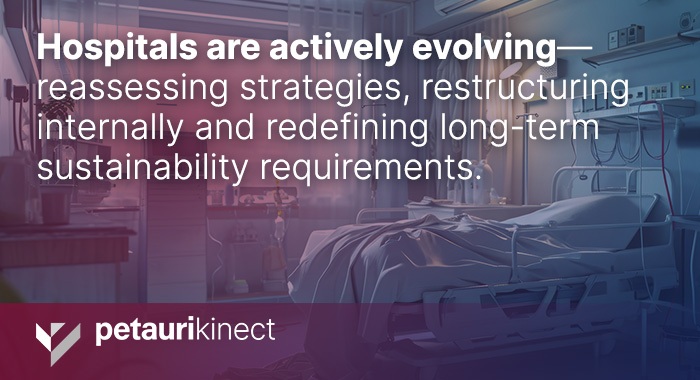Hospitals Face Heightened Pressures – An Opportunity for Strategic Progress

New Market Dynamics Demand a New Approach to Customer Engagement
U.S. hospitals are operating in one of the most challenging and complex environments in recent history. Amid workforce instability, shrinking margins, rising quality expectations and layered decision-making, health systems are under relentless pressure to deliver more with less.
While the landscape is challenging, it is not static. Hospitals are actively evolving by reassessing strategies, restructuring internally and redefining long-term sustainability requirements. For life science companies, understanding these dynamics is no longer optional.
In an ecosystem defined by constraints and change, collaboration must be strategic and frictionless. A focused hospital engagement strategy is essential to support the adoption of medical interventions in ways that meet hospitals where they are at.
Financial Pressures are Reshaping Priorities
Hospitals face an increasingly complex financial reality driven by inflation, rising input costs and chronically narrow margins. Approximately half of U.S. hospitals ended 2022 with a negative profit margin.1,2 As hospitals invest more to stabilize their workforces, other priorities—such as capital investments, service line expansions and innovations—are often delayed or deprioritized. Even well-resourced institutions are under pressure to justify spending and make trade-offs to preserve flexibility. The shift to value-based care has not yet closed the gap between reimbursement and the real-world cost of delivering care. For external partners, this means engaging with hospitals requires more than demonstrating clinical value—it requires showing awareness of operational and resource realities.
Staff Constraints Undermine System Capacity
Persistent workforce shortages, high turnover rates, rising costs of contract providers and escalating clinician burnout remain acute, particularly in nursing and pharmacy. Burnout affects over half (53% to 65%) of healthcare workers,3-5 and the combination of this with declining retention and limited training pipelines has reduced the availability of qualified staff. Hospitals are increasingly reliant on contract labor, which can cost two to three times more than full-time staff. The average hospital spends $7.6 million annually in this area—a 258% surge from 2019.6,7 The downstream effects extend beyond labor costs. Staffing shortages reduce bandwidth for new programs, protocols and performance initiatives. Innovation is more challenging to absorb when hospitals are already stretched thin. For life science companies, this calls for engagement strategies that reduce complexity, minimize administrative lift and share in the work of change.
Quality Benchmarks Are Expanding, and So Are Demands
Hospitals today must do more than deliver care. They are measured against an expanding set of performance metrics including safety, experience, readmissions, equity and more. Each of these benchmarks directly impacts reimbursement, ranking, reputation and compliance. Meeting these benchmarks requires robust data infrastructure, consistent cross-functional coordination and ability to adapt to shifting policy and payer priorities. While many systems have invested in performance improvement infrastructure, those efforts are often limited by competing demands. Even when new solutions support quality objectives, complex dynamics can slow down adoption. The opportunity lies in helping hospitals translate alignment into action; by offering solutions that integrate easily and support consistency at scale.
Leadership Complexity Is Slowing Decision-Making
Hospital decisions are increasingly made by multiple leaders, departments and even organizations. With more hospitals operating within integrated health systems, priorities are determined upstream, and decision-making requires consensus among pharmacy, IT and service-line leaders as well as system-level executives. As a result, review cycles are longer, data demands are higher and implementation pathways are more rigorous. For solutions to succeed, they must not only meet the need but also align with the institutional decision-making cadence. Strategic partners can create real value by supporting hospital leaders in redefining long-term sustainability and in charting an actionable path to achieve it.
Life Science Organizations Can Play a Critical Role in Supporting Health Systems
Beyond developing life-saving therapies, biopharmaceutical companies have an opportunity to collaborate with hospitals to identify more efficient and sustainable ways to deliver care as demand continues to outpace resources. The goal isn’t just to get treatments adopted, it is to help integrate them into systems strained by complexity and constraint. For example, introducing tools that optimize workflows, support cross-functional collaboration and align with performance priorities are critical. From predictive analytics to team-based care solutions, opportunities exist to reduce friction in the delivery of care. The key is understanding what success looks like from the hospital’s point of view, and then building toward it, together.
Petauri Kinect Helps Navigate the Pressures Facing Hospitals Today
The pressures facing hospitals across the U.S. are significant and have far-reaching consequences for healthcare access and quality. Addressing these pressures requires a coordinated effort; governments, insurers, healthcare providers, and life science companies all have a part to play in ensuring hospitals can continue delivering high-quality care to the communities they serve.
At Petauri Kinect, we understand the complex dynamics at play, the critical stakeholders involved, the key drivers and priorities, how decisions are made, and how interventions are implemented within pathways and protocols. We help organizations develop innovative strategies that align with hospital priorities, drive meaningful impact, and support the adoption of treatments that enhance patient care. As the only strategic advisory and marketing agency dedicated to health systems and therapeutic area dynamics, we pave the way towards redefining what hospital customer-centricity looks like.
We encourage you to stay tuned and reach out about our experience in developing optimal hospital engagement strategies.
References
1. KaufmanHall. National hospital flash report. Published January 2023. Accessed June 11, 2025. https://www.kaufmanhall.com/sites/default/files/2023-01/KH_NHFR_2023-01.pdf
2. Lalani K, Helton J, Vega FR, et al. The impact of COVID-19 on the financial performance of the largest teaching hospitals. Healthcare. 2023;11(14):1996. Accessed June 11, 2025. https://www.mdpi.com/2227-9032/11/14/1996
3. Jarrett JB, McQuade BM. Pharmacist burnout: the real dilemma and missing pieces. Am J Health Syst Pharm. 2022;76(16):1181-1182. doi:10.1093/ajhp/zxz131
4. What is nurse burnout? How to prevent it. American Nurses Association. Accessed June 11, 2025. https://www.nursingworld.org/content-hub/resources/workplace/what-is-nurse-burnout-how-to-prevent-it/
5. Measuring and addressing physician burnout. American Medical Association. Updated May 3, 2023. Accessed June 11, 2025. https://www.ama-assn.org/practice-management/physician-health/measuring-and-addressingphysician-burnout
6. Average contract labor expenses at U.S. hospitals. Definitive Healthcare. Published August 3, 2023. Accessed June 11, 2025. https://www.definitivehc.com/resources/healthcare-insights/average-contract-labor-spend-us-hospitals
7. Hospital Vitals: Financial and Operational Trends. Syntellis and American Hospital’s Association. Accessed June 11, 2025. https://www.syntellis.com/sites/default/files/2023-03/AHA%20Q2_Feb%202023.pdf

Share